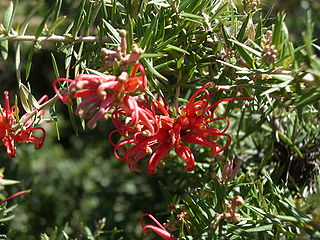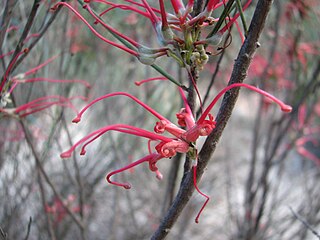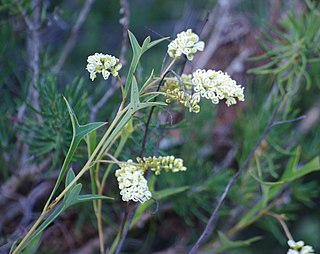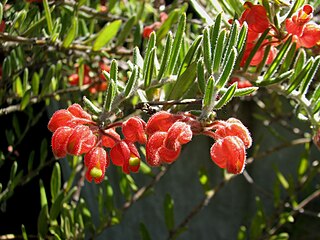
Grevillea is a diverse genus of about 360 species of evergreen flowering plants in the family Proteaceae, native to rainforest and more open habitats in Australia, New Guinea, New Caledonia, Sulawesi and other Indonesian islands east of the Wallace Line. It was named in honour of Charles Francis Greville, an 18th century patron of botany and co-founder of the Royal Horticultural Society. The species range from prostrate shrubs less than 50 cm (20 in) tall to trees 35 m (115 ft) tall. Common names include grevillea, spider flower, silky oak and toothbrush plant. Closely related to the genus Hakea, the genus gives its name to the subfamily Grevilleoideae.

Grevillea juniperina, commonly known as juniper- or juniper-leaf grevillea or prickly spider-flower, is a plant of the family Proteaceae native to eastern New South Wales and south-eastern Queensland in Australia. Scottish botanist Robert Brown described the species in 1810, and seven subspecies are recognised. One subspecies, G. j. juniperina, is restricted to Western Sydney and environs and is threatened by loss of habitat and housing development.

Grevillea lavandulacea, commonly known as lavender grevillea, is endemic to south-eastern South Australia and western and central Victoria.

Grevillea pilosa is a low growing shrub which is endemic to the south-west of Western Australia. It grows to between 0.4 and 1 metre in height and produce red or pink flowers between June and December in its native range.

Grevillea drummondii, or Drummond's grevillea, is a shrub which is endemic to the south west region of Western Australia.
Grevillea centristigma is a shrub which is endemic to the south west region of Western Australia.

Grevillea pinaster is a shrub in the family Proteaceae. It is endemic to south-western Western Australia.

Grevillea sarissa, the wheel grevillea, is a shrub which is native to South Australia and Western Australia. It grows to between 0.6 and 3.5 metres in height and produces yellow, red or pink flowers between August and December in its native range.
Grevillea acrobotrya, is a shrub which is endemic to the southwest of Western Australia.
Grevillea acuaria is a shrub which is endemic to the south of Western Australia.

Grevillea stenomera, commonly known as lace net grevillea, is a shrub in the family Proteaceae. It is endemic to Western Australia, occurring between Kalbarri and Tamala.

Grevillea synapheae, the catkin grevillea, is a shrub in the family Proteaceae. It is endemic to the southwest of Western Australia, occurring in low heathland.

Grevillea maccutcheonii, commonly known as McCutcheon's grevillea, is a rare shrub in the family Proteaceae. It is endemic to south-western Western Australia, where only 7 mature plants remain in the wild. It usually grows to 2 metres in height and width The distinctively-shaped leaves are stem clasping with 3 rounded lobes, each tipped with a spine. The flowers, which have a reddish green perianth and a red style, appear predominantly between July and November in the species' native range, but may appear sporadically throughout the year.
Grevillea stenobotrya is a shrub in the family Proteaceae. It is endemic to arid regions of Australia. Common names include rattle-pod grevillea, sandhill grevillea and sandhill spider flower. Plants grow to between 1.5 and 6 metres in height and have leaves are linear and entire, or occasionally divided, and between 6 and 28 cm long and 0.7 to 2.5 mm wide. Flowers are cream, pale yellow or pale pink. These appear in clustered spikes at the end of branches between May and December in the species' native range. The fruits which follow are hard, flattened and rounded and have a short beak.

Grevillea saccata, commonly known as pouched grevillea, is a shrub which is endemic to the south-west region of Western Australia. It grows to between 0.25 and 0.5 metres in height. The red flowers usually appear from June to November in the species' native range. The species was formally described in 1870 by English botanist George Bentham in his Flora Australiensis.

Grevillea asteriscosa, commonly known as star-leaf grevillea, is a shrub which is endemic to the south-west region of Western Australia. It grows to between 0.3 and 2.6 metres in height. The red flowers usually appear from July to November in the species' native range.
Grevillea brachystylis grandis, commonly known as large-flowered short-styled grevillea, is a subspecies of Grevillea brachystylis.
Grevillea fuscolutea is a shrub of the genus Grevillea native to a small area along the south coast in the Great Southern region of Western Australia.
Petrophile latericola is a species of flowering plant in the family Proteaceae and is endemic to southwestern Western Australia. It is an erect shrub with needle-shaped leaves and spherical heads of bright yellow flowers.












